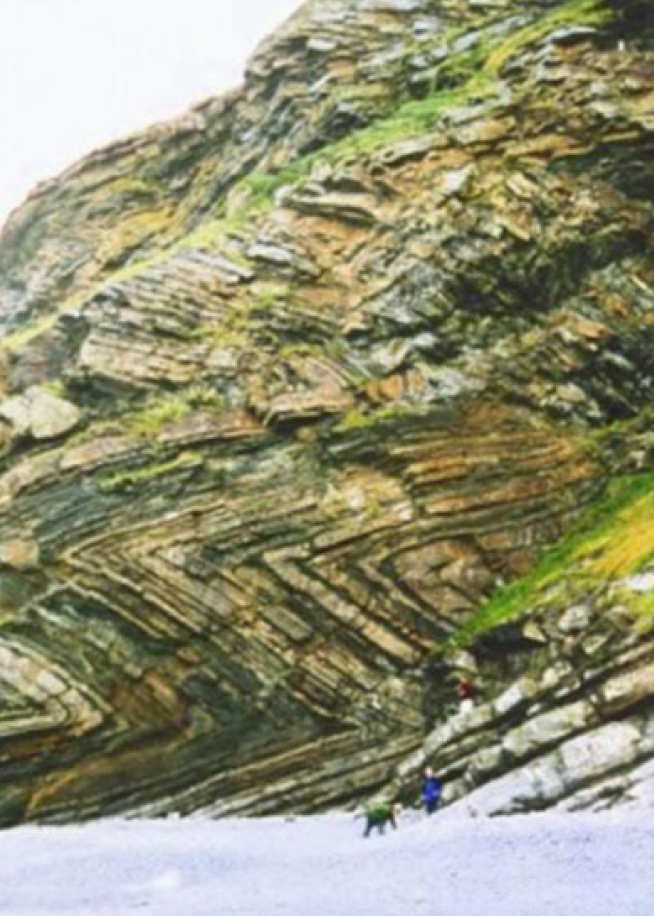Kink banding in layered structures and materials
Research Team
- Professor Ahmer Wadee: Imperial College London
- Dr Rorie Edmunds: Imperial College London
- Professor Giles Hunt: University of Bath
- Professor Mark Peletier: Technische Universiteit Eindhoven
- Professor Roger Hobbs: Imperial College London
Background

Kink banding is a distinctive form of structural response, similar in essence to buckling, which is found in various areas of structural mechanics with differing significance and physical scales. For instance, geological strata under high overburden pressure in conjunction with layer-parallel plate tectonic compression can exhibit this form of deformation. This process can be used as a fingerprint by geologists to help locate mineral or precious metal deposits. In the composite materials context, kink banding is the principal mode of structural failure in laminated fibre composites that are subjected to compression parallel to the laminae. Kink bands can also form within fibre ropes that are bent to a large curvature when, for example, they pass over a pulley because of the introduction of a region of compression. This can inherently weaken the rope's internal structure and potentially compromise its structural performance. All of the above cases have been studied in depth: (i) kink banding in geological strata; (ii) kink banding in individual aramid fibres such as Kevlar that are employed in the construction of high performance ropes and cables and (iii) kink banding in laminated fibre composites under compression parallel to the laminae.
This research was initiated during the latter stages of EPSRC research project GR/L17177 (1998-9). The principal investigators then were Professors Giles Hunt and Chris Budd of the University of Bath. Professor Mark Peletier, who is at the Technische Universiteit Eindhoven in The Netherlands was the original PDRA employed on this project. Giles and Mark continued to collaborate in the EPSRC research project GR/R37173 (2002-5), the team now including Dr Rorie Edmunds and Professor Roger Hobbs.
Context and Methodology
The research for the first application was conducted in collaboration with colleagues from the Centre for Nonlinear Mechanics at the University of Bath and Technische Universiteit Eindhoven. Small-scale laboratory experiments were conducted at Imperial to simulate tectonic action on layered media under a high overburden pressure [1]. This showed that the appearance of kink bands was associated with very severe instabilities rapidly leading to large rotations and loss of total strength in the mechanical system. These effects have been successfully demonstrated in a simplified mathematical model that captures the influence of the important physical parameters. Key quantities such as load versus displacement relationships, angles of deformation and kink band widths can now be predicted quantitatively with unprecedented accuracy when compared to the experiments [2]. The model was then extended to account for the appearance of multiple bands [3] and so-called parallel folding [4] with, again, excellent comparisons between experiment and theory.
The research for the second application was conducted in collaboration with our industrial partner, Tension Technology International Limited, a firm of consulting engineers specializing in the production and application of high-performance composite fibre ropes, moorings and cables. They provided the research team with valuable data to compare our model against. In this case, the model was adapted for the subtly different geometries and effects at the microscopic scale and, again, quantitative correlation between the model and published experiments was excellent [5]. Further developments in modelling have been achieved and these are detailed on the page for research into laminated composites.
Seminars and Conference Presentations
- August 2009
Council for Geoscience, Pretoria. GeoIndaba. - November 2006
Imperial College London, Department of Aeronautics. Aerodynamics and Aerostructures seminars. - September 2004
Castro Urdiales, Cantabria, Spain. Euromech Colloquium 464 on Fibre Reinforced Solids: Constitutive Laws and Instabilities. Conference Presentation. - December 2003
University of Bath, Centre for Nonlinear Mechanics. DAFT Day 2: Folding Patterns in Structural Geology, Theory and Experiments. Invited contribution. - July 2003
New Orleans, Louisiana, USA. 10th International Conference on Composites/Nano Engineering. Invited Distinguished Lecture. - August 2002
University of Bath, Delamination and Folding Team (DAFT) Day 1. Invited contribution. - April 1999
University of Bath, 1999 British Applied Mathematics Colloquium.
Geological Mini-Symposium Presentation. - March 1999
University of Bath, Centre for Nonlinear Mechanics. Brooke Session.
San Antonio, Texas, USA. 5th SIAM Conference on Mathematical and Computational Issues in the Geosciences. Conference Presentation.
References
- Hunt, G. W., Peletier, M. A. and Wadee, M. A., 2000. The Maxwell stability criterion in pseudo-energy models of kink banding. J. Struct. Geol., 22(5):669-681.
- Wadee, M. A., Hunt, G. W. and Peletier, M. A., 2004. Kink band instability in layered structures. J. Mech. Phys. Solids, 52(5):1071-1091.
- Wadee, M. A. and Edmunds, R., 2005. Kink band propagation in layered structures. J. Mech. Phys. Solids, 53(9):2017-2035.
- Edmunds, R., Hunt, G. W. and Wadee, M. A., 2006. Parallel folding in multilayered structures. J. Mech. Phys. Solids, 54(2):384-400.
- Edmunds, R. and Wadee, M. A., 2005. On kink banding in individual PPTA fibres. Compos. Sci. Technol., 65(7-8):1284-1298.
Final report to EPSRC can be downloaded from here.


